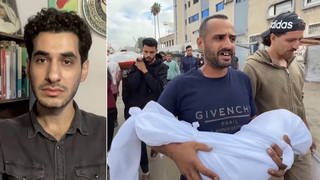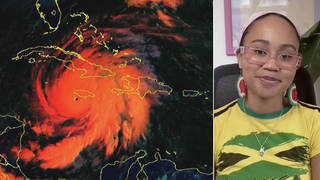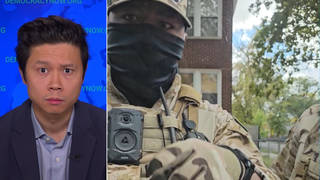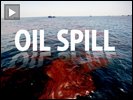
It has been eight months since the explosion aboard the Deepwater Horizon set off the worst offshore oil spill in U.S. history. Eleven workers were killed and more than 200 million gallons of oil were dumped into the Gulf of Mexico. A major investigation by the New York Times takes an in-depth look into how explosion occurred. Based on interviews with 21 crew members and testimony from 94 others, the investigation concludes every single one of the rig’s defenses failed. We speak with Pulitzer Prize-winning journalist David Barstow. [includes rush transcript]
Transcript
JUAN GONZALEZ: “The worst of the explosions gutted the Deepwater Horizon stem to stern.
“Crew members were cut down by shrapnel, hurled across rooms and buried under smoking wreckage. Some were swallowed by fireballs that raced through the oil rig’s shattered interior. Dazed and battered survivors, half-naked and dripping in highly combustible gas, crawled inch by inch in pitch darkness, willing themselves to the lifeboat deck.
“It was no better there.”
That is the opening line of the New York Times exposé on one of the biggest stories of 2010: the BP oil spill. It’s been eight months since the explosion aboard the Deepwater Horizon set off the worst offshore oil spill in U.S. history. Eleven workers were killed, and over 200 million gallons of oil were dumped into the Gulf of Mexico.
Earlier this month, the federal government took the first legal action to come out of a series of probes, suing BP and eight other companies for cleanup costs and environmental devastation under the Clean Water Act and the Oil Pollution Act. Attorney General Eric Holder unveiled the case.
ATTORNEY GENERAL ERIC HOLDER: The United States alleges violations of federal safety and operational regulations, including a failure to take the necessary precautions to secure the Macondo well prior to the April 20th explosion; failure to utilize the safest drilling technology to monitor the well’s condition; failure to maintain continuous surveillance of the well; and failure to utilize and to maintain equipment and materials that were available and necessary to ensure the safety and protection of personnel, property, natural resources, as well as the environment.
JUAN GONZALEZ: More lawsuits are expected as governmental investigations proceed. But some companies have been accused of obstructing fact-finding efforts to determine liability. On Wednesday, Transocean, the owner of the Deepwater Horizon rig, said it won’t honor subpoenas issued by investigators with the U.S. Chemical Safety Board. The board has challenged Transocean’s monitoring of testing on the blowout preventer that failed during the explosion and then has accused the company of withholding key documents and barring access to witnesses. Transocean says the board doesn’t have proper jurisdiction.
AMY GOODMAN: Well, this week, the New York Times came out with a major investigation into how the explosion aboard the Deepwater Horizon occurred. Based on interviews with 21 crew members, testimony from 94 others, the investigation concludes every single one of the rig’s defenses failed. According to the piece, the defense mechanisms either didn’t work, were activated too late, or weren’t deployed at all.
David Barstow is a Pulitzer-Prize winning journalist for the New York Times. He wrote the oil spill piece with David Rohde and Stephanie Saul. It’s called “Deepwater Horizon’s Final Hours.” David Barstow joins us here in our studio.
Welcome to Democracy Now!
DAVID BARSTOW: YThank you.
AMY GOODMAN: This is an exhaustive investigation. You spent five months on it. And I think what’s most powerful about it are the individual stories you tell of the workers onboard. But why don’t you, in these last hours of 2010, lay out for us what happened? Tell that story, as they did, one of the biggest stories of 2010.
DAVID BARSTOW: Well, you have this oil rig, which we’ve all seen photographs of, this enormous structure 50 miles out in the Gulf of Mexico, and it went down after the oil spill. And I think many people sort of assume that it was like an inevitable kind of casualty of the blowout itself. But in fact, this oil rig was kind of like the Titanic. I mean, it was this incredible apparatus, this marvel of engineering, and it had all of these systems, these safety systems — state of the art, many of them — that were all designed to prevent the very thing that happened from happening.
And not only that, what also was striking about this is that it had a crew that was trained, trained frequently, on how to respond to blowouts, how to respond to fires, how to get off the rig quickly. And it also had leaders on this rig who had decades of experience in drilling in deepwater environments, and they knew all about blowouts, kicks, well control problems. And yet, on this night, on April 20th, every one of those systems, every one of those rehearsals, drills, etc., it all failed, and failed miserably.
And it didn’t fail because people were — you know, wanted something bad to happen or were not trying to do the best that they could, but what we discovered was that there was a kind of paralysis that gripped this vast rig in critical places at critical times. And what it resulted in is it resulted in people not taking the steps, not deploying some of these safety systems, or trying to deploy them but deploying them too late, when the damage had already been done.
And the net effect of this paralysis is that for nine minutes, from when the blowout first hit the rig until these crippling explosions that basically left this a dead ship, those nine minutes, there was no alarm, general alarm, issued to the 126 people who were on this rig. So, for most of the people on the rig, the first time they really understood that there was a major crisis going on was when the explosions ripped through this oil rig, in many cases injuring people, in some cases quite, quite devastating injuries — burns, broken bones, that kind of thing.
JUAN GONZALEZ: Well, David, it is a fascinating account. And as I told you before the show started, it’s not every day that I read a full New York Times multi-page story. But this one really read like a novel, in terms of what actually happened. And especially, as you say, it wasn’t just a failure of the equipment, but there were several moments when key decisions were made by these experienced people that, had they made a decision one way —
DAVID BARSTOW: Yes.
JUAN GONZALEZ: — there would have been a far different result. And I’m wondering if you could go through some of those and the — beginning from what they were doing, actually, which was actually monitoring the well itself before capping it, and then going through some of the key mistakes that occurred.
DAVID BARSTOW: Yeah. One of the ways that I put it in the piece was that this rig was like a kind of a Gulf Coast town that was well prepared for Category 1 hurricanes but never contemplated what they would do when they were hit with a hundred-year storm. And it was sort of — you could see this even in the training policies. They were given very big, thick guidelines from Transocean, the owner of this rig, on when they should deploy these various systems. But there was a kind of a contradiction in these policies. The policies would say, “You really need to act quickly. It’s crucial. The history of oil rig disasters is the history of small problems that don’t get addressed right away.” And yet, they would also say, “But there’s a really big danger if you overreact. And if you overreact, then it could cost us a lot of money, it could create other safety issues.” And you see moments along the way where that contradiction essentially froze key people at key times.
And the best example I can think of on this point is what happened on the bridge. You have the bridge of this rig. You have a captain. You have other officers. And several minutes into this crisis, all of a sudden the computer consoles started lighting up with gas alarms. And there are gas alarms that are — there are detectors all over this rig that are constantly sensing and detecting even the slightest trace of gas. And when they detect really high levels of gas, the alarms are colored magenta. And all of a sudden, on these computer consoles in the bridge, there were dozens of magenta lights lighting up. Well, the officers on this rig had trained on what you do when you see a magenta light or one alarm going off. And they had a whole sort of procedure set up. First you acknowledge the alarm. Then you silence the alarm. Then you call the captain. You call the other supervisors. You send somebody with a handheld detector to go check the area, confirm the alarm. Then you come back. And it contemplated a much smaller kind of crisis. But when they were confronted with dozens of alarms going off all at once, they didn’t know what to do. They hadn’t been trained for that moment. And they said, quite frankly, you know, “We just didn’t know what to do.”
Likewise, they have another — right at the same console where they have these magenta lights going off, they have another system that allows them to shut down ventilation systems, shut down electrical systems to prevent a source of ignition. They even have a button that would shut down the main engines on the rig, which were the things that ultimately exploded so devastatingly on this rig. But this is a system that is incredibly complex. One of these systems takes 30 different buttons that you have to pick from in order to deploy it and deploy it under the crunch of time. If you can imagine, put yourself in the shoes of those people on that bridge. This system had initially been designed to be automatic. Transocean set some of these systems so that they basically required a human being to make the correct decision at the correct time, armed with the correct information. You kind of needed a triple-bang shot of all the right things to occur. And what happened again and again and again that night was that you didn’t have the right people with the right information with the right systems. And what happened was this kind of paralysis.
AMY GOODMAN: Why did they stop it from being automatic?
DAVID BARSTOW: For a variety of reasons. Transocean now argues that on a sophisticated rig operating in these conditions that it can actually be more dangerous if you have automated systems. They also argue that if you have alarm systems that trigger automatic evacuation sirens all the time, and those turn out to be false alarms, that it will be sort of the “cry wolf” syndrome, and people will stop listening and reacting in the same way.
AMY GOODMAN: We’re going to go to break and then come back to Pulitzer Prize-winning investigative reporter David Barstow, who led the investigation five months into the final hours of the Deepwater Horizon, looking at what they call onboard the vessel “the well from hell.” This is Democracy Now! Back in a minute.
[break]
AMY GOODMAN: We want to turn to a clip from the New York Times website that accompanies the investigative piece led by David Barstow, our guest today. It features an interview with Deepwater crew member Caleb Holloway describing his final minutes on the rig. He was with another crew member, Daniel Barron.
CALEB HOLLOWAY: It was just everywhere. It was blowing up so intense that it was just bouncing off of everything.
NARRATOR: Holloway had trained for emergencies, but not for this. He tried to radio his boss in the drill shack.
CALEB HOLLOWAY: I didn’t get a response. I didn’t — we didn’t know what to do.
NARRATOR: He needed to find cover, so he followed Barron to the heavy tool house, which had a phone linked to the drill shack. But he smelled gas.
CALEB HOLLOWAY: Gas, just felt it all over, all over me. I felt it, and I smelled it, tasted it. And I just knew that that was bad. And that’s when I kind of — I kind of panicked a little bit. And I looked at Daniel, and I said, “Daniel, that’s gas. We have to get out of here.”
NARRATOR: Gas sensors went off, but the bridge failed to activate emergency systems that might have prevented gas from spreading or igniting. They also failed to immediately sound the general alarm to start evacuation. Meanwhile, Holloway and Barron headed toward the lifeboat deck. On the way, the lights went out. Then they heard the first explosion.
CALEB HOLLOWAY: I kind of ducked down like that and grabbed my hard hat.
NARRATOR: That explosion and a second larger one are believed to have centered in these engine rooms. Four men in the engine control room were caught in the blasts but managed to survive.
CALEB HOLLOWAY: We get down to the lifeboat deck, and I open one of the boxes, get Daniel a life jacket and say, “Get ready to get in one of the lifeboats.”
NARRATOR: Holloway noticed that few of the crew had made it to the lifeboats. He climbed out and saw the door to the crew’s quarters had been blown open. A group of disoriented men stumbled from a darkened hallway. He used his flashlight to guide them out.
CALEB HOLLOWAY: All these guys started piling out. And it was completely pitch black in there. You couldn’t see anything.
NARRATOR: Towering over them, the derrick was in flames. One of his buddies crawled over the handrail to jump into the water.
CALEB HOLLOWAY: He slips and fall — and just loses all his grip, and he’s going down. And he hits his leg on the way down, and he’s tumbling.
NARRATOR: The friend survived the 60-foot fall and swam to safety. Holloway was one of the last to get into his lifeboat.
CALEB HOLLOWAY: But the fire was intense, and it was the heat. People were worried about the derrick, you know, melting and falling towards the lifeboat.
NARRATOR: The lifeboat descended into an eerily calm sea.
CALEB HOLLOWAY: I felt I was carried off that rig by, you know, God’s righteous right hand.
NARRATOR: A nearby supply ship became a refuge for the survivors.
CALEB HOLLOWAY: And I just kept going around, person to person, and asking them, “Have you seen — have you seen Shane? Have you seen Adam? Have you seen Roy? Seen Carl?”
NARRATOR: The next morning, the survivors gathered on the deck.
CALEB HOLLOWAY: We had a moment of silence. And I mean, you know, after that was done, I had to walk — walk off. And then, you know, a couple people came over there and, you know, were asking, “Are you alright? You alright?” “Yeah, just give me a minute. Just give me a minute.” But, really wasn’t alright.
AMY GOODMAN: That New York Times video featured Deepwater crew member Caleb Holloway. The complete video can be seen at nytimes.com, and we’ll link to it at our website. Juan?
JUAN GONZALEZ: Yeah, David, in your article, you point again to some of the mistakes that were made, like the failure to bring in the emergency disconnect system, also the failure to, when the oil started gushing up, to redirect it out to the ocean. And overall, the story does not paint a very good picture of the decisions of the captain of the rig. Could you talk about some of those decisions and what the crew did or didn’t do?
DAVID BARSTOW: I think the most controversial moment with the captain himself comes from an allegation that was made by the chief engineer on the rig, who said that during the evacuation process, that at one moment the captain suggested leaving behind a very badly wounded crew member. The captain has denied that through his lawyer. But what emerges in the interviews and in the testimony, especially about the captain, is a sense of a young man — he’s 34 years old, I believe, had been a captain for a couple of years — who seemed like what he was really trying to do was sort of say, “OK, everything is OK. Everything is — be calm. This isn’t as bad as it might look,” and was kind of consistently counseling against taking the kind of really decisive steps that, in retrospect, looking back, probably did need to be taken. So, for example, one of the really important safety systems is this ability to disconnect the rig from the well — in other words, cut it off from the source of the fire that is consuming this rig. And that’s triggered with something called the emergency disconnect system. And after the explosions, you had some of the crew members saying, “We need to hit this emergency disconnect.” It’s like hitting the eject button if you’re a fighter pilot.
JUAN GONZALEZ: Just get away from it, get away — take the rig away from the fire.
DAVID BARSTOW: Get away. And there was a reluctance on the part of the captain to take that step, even though, at that point, they had no power, they were burning, explosions going off all over the place. And so, that was, I think, a moment where you see this kind of “push me, pull you” of the Transocean safety policies coming into a moment where it leads someone like that into a kind of — some indecision.
JUAN GONZALEZ: And yet, this was, as you mentioned, the Titanic of oil rigs, so supposedly this was the state of the art. What does this say about other rigs out there in the Gulf and about the future of deepwater drilling, in general, and what the government should be wary about long term?
DAVID BARSTOW: Yeah, this is really one of the remarkable aspects of this story. These are not like fly-by-night operators. These are not second-, third-tier operators. These are the A team. This is the — you know, the first string of deepwater drilling in the Gulf of Mexico. And the fact that this rig, with this crew, could go down in this fashion, I think, raises some really important questions about the other rigs that are going to be continuing to drill in very tough circumstances out in the Gulf of Mexico.
AMY GOODMAN: Because Obama has lifted the moratorium on offshore drilling.
DAVID BARSTOW: He has. He has lifted the moratorium. And one of the critical safety devices in this whole mess is this thing called a blowout preventer. And this is the thing that rests on the seabed, and it is this five-story-tall, hundreds — you know, just a massive device that is supposed to be triggered from the rig itself to seal the well — is supposed to be triggered from the rig itself to seal the well in an emergency, in this case. Transocean has made a really remarkable argument lately. They have argued that this blowout preventer simply wasn’t capable of preventing this blowout. Well, that’s a remarkable thing, because the blowout preventer is the key safety device for all of these rigs out there in the Gulf of Mexico. And if they’re sitting on top of blowout preventers that are not, as the industry has long portrayed, the kind of ultimate fail-safe device, then this is something that I think would be a major issue for regulators at the Interior Department who are trying to think about how do we go forward with deepwater drilling in a way that doesn’t result in another one of these, you know, next year or the year after.
AMY GOODMAN: The issue of Obama lifting the moratorium, did it surprise you?
DAVID BARSTOW: Well, not when you spend any time down on the Gulf Coast, when you spend time down there and you understand the centrality of the oil-drilling industry to the entire economy along that part of the coastline, and you begin hearing and feeling the political pressure that builds. And it’s not like a Republican or — I mean, they’re all in agreement that we’ve got to get going again. When you see the kind of lifestyles that come with this industry — I mean, this is one of the remarkable things about this crew. I mean, this really, in a way, is one of the final really great blue-collar jobs left in America. You know, this is a rig where someone with a high-school degree or a little bit of community college can go out and can make $150,000, $160,00, $170,000 a year, great benefits, great vacation. You know, just —- it is giving the sort of -—
AMY GOODMAN: And yet, you have this scene of them jumping through fireballs —
DAVID BARSTOW: Exactly.
AMY GOODMAN: — into a blazing sea.
DAVID BARSTOW: Absolutely, yes. Exactly.
JUAN GONZALEZ: David, I’d like to ask you also about that. There’s been some criticism of your series by other colleagues, Associated Press, in particular, which has distinguished itself by covering this story for throughout the year, claiming that much of the conclusions that you reached, of the reporting, had previously been done by them and other news organizations, and there was really nothing that new in this story. I’m interested in your response to that.
DAVID BARSTOW: The first I heard of it was when I heard that the managing editor of the Associated Press had called to apologize to our editors for that letter that was written by a reporter who was covering the oil spill for them. The fact of the matter is that, as we said in the story, this was based on interviews with 21 crew members and also a very careful piecing together of testimony from 94 others. So I can understand why, you know, an Associated Press reporter who’s sitting there day in and day out writing short items about this or that snippet of testimony feels upset when we come along with an 8,500-word story that includes some of the stuff that he no doubt wrote about here and there.
But I think what — if you go back and you look at the coverage, a lot of the coverage focused early on really on what caused the blowout, and so that’s why we heard so much about well design and about cementing practices. And in the kind of look that we did at what actually caused this massive piece of equipment to go down at the cost of 11 lives, that’s something that, you know, we all — you know, we look at the clips, we look at what’s been done, and we saw that that was an area that really hadn’t gotten the kind of attention that we thought an event of this magnitude really deserved. And that’s what we — that’s what we thought.
AMY GOODMAN: And finally, what most surprised you in your five-month investigation?
DAVID BARSTOW: What most — what most surprised me is — I know that we heard a lot early on about BP’s safety culture. And it’s true, they have a very troubling safety culture, and it’s been well documented in a number of different areas, such as Texas City and in Alaska and in California. But the truth of the matter is that this is actually a little more complicated, because the safety culture on Deepwater Horizon really wasn’t the BP safety culture. It was actually the Transocean safety culture. And that’s a very different thing from the BP safety culture. And I think it would be in some ways comforting if we could all think, well, this is really just a story about a company that cut corners on safety, and this is the end result. What makes it more complicated and troubling in some ways is that that wasn’t the case here. Transocean is a company with a very strong and potent safety culture. And that this could happen on this rig in that culture with these people should give us a lot more reason to think more deeply about what it means to do deepwater drilling in the Gulf of Mexico.
AMY GOODMAN: Well, we want to thank you very much, David Barstow, for joining us, twice Pulitzer Prize-winning reporter at the New York Times_. We will link to the r=1”>exposé, “Deepwater Horizon’s Final Hours,” at our website, democracynow.org.












Media Options